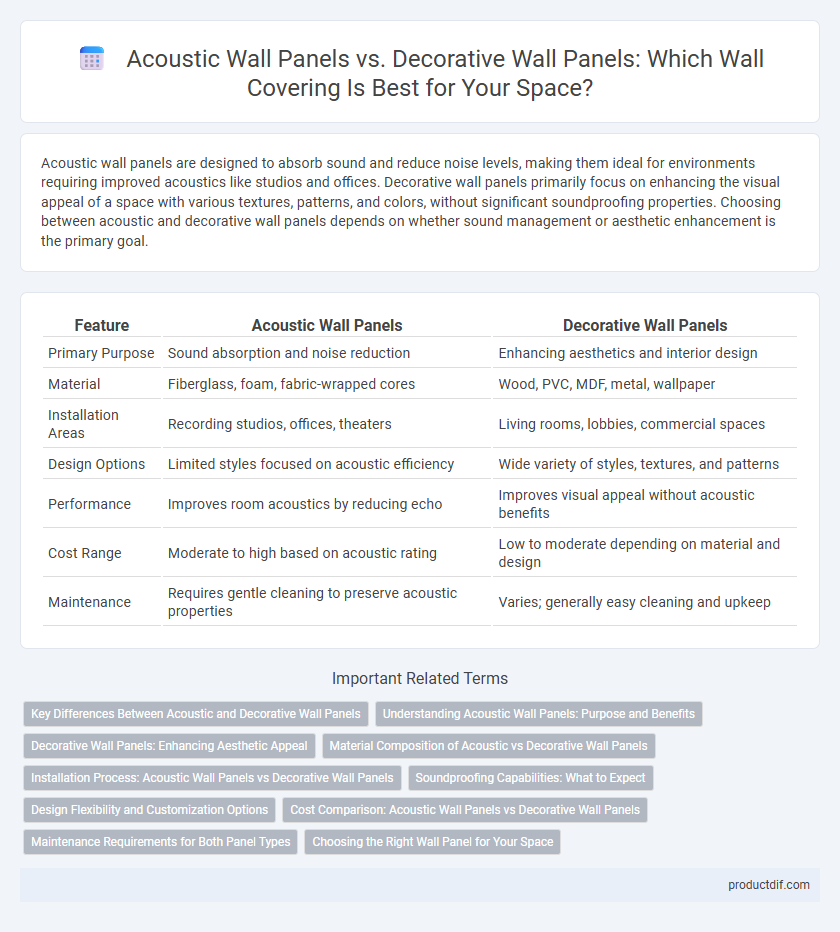Acoustic wall panels are designed to absorb sound and reduce noise levels, making them ideal for environments requiring improved acoustics like studios and offices. Decorative wall panels primarily focus on enhancing the visual appeal of a space with various textures, patterns, and colors, without significant soundproofing properties. Choosing between acoustic and decorative wall panels depends on whether sound management or aesthetic enhancement is the primary goal.
Table of Comparison
| Feature | Acoustic Wall Panels | Decorative Wall Panels |
|---|---|---|
| Primary Purpose | Sound absorption and noise reduction | Enhancing aesthetics and interior design |
| Material | Fiberglass, foam, fabric-wrapped cores | Wood, PVC, MDF, metal, wallpaper |
| Installation Areas | Recording studios, offices, theaters | Living rooms, lobbies, commercial spaces |
| Design Options | Limited styles focused on acoustic efficiency | Wide variety of styles, textures, and patterns |
| Performance | Improves room acoustics by reducing echo | Improves visual appeal without acoustic benefits |
| Cost Range | Moderate to high based on acoustic rating | Low to moderate depending on material and design |
| Maintenance | Requires gentle cleaning to preserve acoustic properties | Varies; generally easy cleaning and upkeep |
Key Differences Between Acoustic and Decorative Wall Panels
Acoustic wall panels primarily focus on sound absorption and noise reduction through materials like fiberglass or foam, enhancing room acoustics in spaces such as recording studios and offices. Decorative wall panels emphasize aesthetic appeal and design variety, often made from wood, PVC, or fabric, adding texture and visual interest without significantly affecting sound properties. Key differences include material composition, function--sound control versus visual enhancement--and installation environments tailored for specific acoustic or decorative needs.
Understanding Acoustic Wall Panels: Purpose and Benefits
Acoustic wall panels are designed to absorb sound, reducing noise and improving room acoustics by minimizing echo and reverberation. These panels enhance speech clarity and create a more comfortable auditory environment in spaces such as offices, recording studios, and home theaters. Unlike decorative wall panels, acoustic panels prioritize functionality alongside aesthetic appeal, offering benefits like enhanced privacy and sound quality.
Decorative Wall Panels: Enhancing Aesthetic Appeal
Decorative wall panels significantly enhance aesthetic appeal by offering a wide range of textures, patterns, and colors that transform plain surfaces into visually striking focal points. Unlike acoustic wall panels primarily designed for sound absorption, decorative panels emphasize design versatility and customization to complement interior themes and elevate ambiance. These panels are crafted from materials such as wood, MDF, PVC, and metal, delivering both durability and artistic expression for residential and commercial spaces.
Material Composition of Acoustic vs Decorative Wall Panels
Acoustic wall panels are primarily composed of sound-absorbing materials such as fiberglass, mineral wool, or open-cell foam designed to reduce noise and echo. Decorative wall panels, on the other hand, use materials like MDF, PVC, or plywood that emphasize aesthetics rather than sound insulation. The material composition dictates their functional performance, with acoustic panels targeting sound control and decorative panels focusing on visual enhancement.
Installation Process: Acoustic Wall Panels vs Decorative Wall Panels
Acoustic wall panels typically require precise installation to maximize sound absorption, often involving mounting brackets or adhesive strips on clean, flat surfaces for optimal performance. Decorative wall panels generally have a simpler installation process, with options like peel-and-stick backings or lightweight mounting systems suitable for DIY applications. Proper alignment and secure attachment are essential for both types to ensure durability and aesthetic appeal.
Soundproofing Capabilities: What to Expect
Acoustic wall panels are specifically designed to absorb sound and reduce noise reverberation, making them ideal for soundproofing in spaces like recording studios, offices, and home theaters. Decorative wall panels primarily focus on aesthetics and offer limited soundproofing, often providing only minimal noise reduction due to their materials and structure. Expect acoustic panels to significantly improve sound quality and reduce echo, whereas decorative panels enhance visual appeal without substantially impacting soundproofing.
Design Flexibility and Customization Options
Acoustic wall panels offer extensive design flexibility with customizable shapes, sizes, and fabric finishes to optimize sound absorption while complementing interior aesthetics. Decorative wall panels prioritize visual appeal, featuring a wide range of textures, patterns, and materials that enhance ambiance without soundproofing properties. Combining both panel types can achieve tailored acoustic performance alongside personalized design, meeting complex interior design requirements.
Cost Comparison: Acoustic Wall Panels vs Decorative Wall Panels
Acoustic wall panels typically cost between $30 to $100 per panel, reflecting their specialized sound-absorbing materials such as fiberglass or foam, while decorative wall panels range from $15 to $60 per panel depending on the design and material like wood or PVC. Installation expenses for acoustic panels can be higher due to precise placement requirements to maximize soundproofing, whereas decorative panels often allow for simpler, quicker installations. Choosing between the two depends on budget priorities, with acoustic panels offering performance-focused value and decorative panels providing cost-effective aesthetic enhancement.
Maintenance Requirements for Both Panel Types
Acoustic wall panels require regular cleaning with a vacuum or a soft brush to maintain their sound-absorbing properties and prevent dust buildup, while avoiding harsh chemicals that can damage the fabric or foam materials. Decorative wall panels typically demand less frequent maintenance, often needing only occasional dusting or wiping with a damp cloth to preserve their visual appeal and surface finish. Both panel types benefit from prompt stain removal and routine inspections to ensure longevity and aesthetic quality.
Choosing the Right Wall Panel for Your Space
Acoustic wall panels are designed to absorb sound and reduce noise, making them ideal for offices, recording studios, and home theaters where sound control is essential. Decorative wall panels primarily enhance aesthetics with various textures, colors, and materials, perfect for living rooms, restaurants, and commercial spaces seeking visual appeal. Selecting the right wall panel depends on balancing soundproofing needs and design goals to create a functional and attractive environment.
Acoustic Wall Panels vs Decorative Wall Panels Infographic

 productdif.com
productdif.com